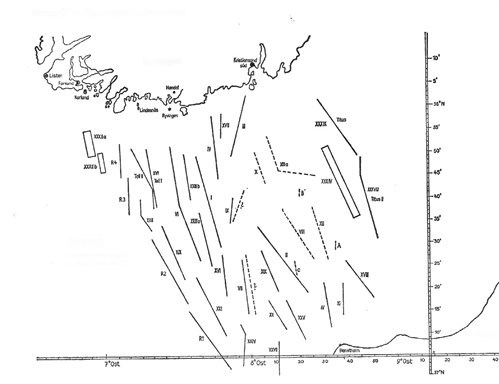Mine barrage in the Skagerrak
During World War II, the German Navy laid a mine barrage in the entrance to the Skagerrak, between Kristiansand and Hanstholm. When the war was over, the Germans had laid a total of 8,810 mines and 4,298 protective buoys in the Skagerrak.
The object of the mine barrage was to prevent Allied warships from entering the Skagerrak. Keeping the British Navy out of the Skagerrak was crucial to Germany throughout the entire period of occupation, since if it had lost control of this waterway, the link between Germany and Norway would have been placed in great danger.
The first mines to form the barrage were laid during the night between 8 and 9 April 1940, and five minefields (I–V) containing a total of 1,642 mines were laid during the rest of that month. An opening measuring approximately 10 nautical miles was left near the coast at each end of the barrage, and German ships were able to pass through these openings without the risk of hitting their own mines. The openings were guarded on both sides of the water by guns on shore and by guard vessels at sea.
The mine barrage was reinforced periodically throughout the remainder of the war – as late as April 1945, attempts were made to lay additional mines. One reason why mine-laying operations continued in the Skagerrak was that the German fear of an Allied attack in the area escalated throughout the war. Another important factor was that reinforcements were necessary if the barrage was to continue to be effective. Naval mine barrages have a limited service life, as tides and currents can either pull the mines loose or cause them to explode. In addition, some mines were also equipped with batteries, which only lasted a certain length of time.
The clearing of the mine barrage was initiated immediately after the end of the war, and the Skagerrak was declared free of mines as early as 1946. Yet even today, fishermen still come across the remains of the minefields when they find sinkers resting on the seabed.

Map of the sea mine fields laid by the German navy in Skagerrak, 1940-1945.
|
Felt |
Code name for operation |
Date |
Sea mines |
Protective buoys |
|
I |
? |
09.04.40 |
384 EMC |
|
|
II |
? |
08.04.40 |
325 EMC |
|
|
III |
? |
12.04.40 |
170 EMD |
|
|
IV |
? |
12.04.40 |
373 EMD |
|
|
V |
? |
24.04.40 |
390 EMC |
|
|
VI |
Halberstadt |
08.01.42 |
597 EMF |
|
|
VII |
Anschluss Halberstadt |
10.01.42 |
268 EMC |
|
|
VIII |
Hannover |
02.03.42 |
210 EMC |
|
|
IX |
Kassel |
25.04.42 |
151 EMC |
|
|
X |
Merkur |
21.05.42 |
66 SMA |
|
|
XI |
Nero |
22.-23.05.42 |
100 EMC |
|
|
XII |
Aachen |
13.06.42 |
65 SMA |
|
|
XIII-A |
Kunigunde |
11.07.42 |
90 EMF |
|
|
XIII-B |
Kunigunde |
11.07.42 |
90 EMF |
|
|
XIV |
Düsseldorf |
08.08.42 |
65 SMA |
|
|
XV |
Oppeln |
13.08.42 |
50 LMF |
|
|
XVI |
Brunswick |
27.01.43 |
248 EMF |
|
|
XVII |
Brunswick |
25.01.43 |
50 EMF |
|
|
XVIII |
Lithium |
08.10.43 |
360 EMC |
|
|
XIX |
Natrium |
11.10.43 |
360 EMF |
|
|
XX |
Großgörschen |
05.03.44 |
250 EMC |
200 RB |
|
XXI |
Leipzig |
15.-16.04.44 |
280 EMF |
350 RB |
|
XXII |
Waterloo |
07-08.05.44 |
300 UMB |
210 EMR |
|
XXIII-A |
Katzbach |
01.-02.04.44 |
230 EMF |
230 EMF |
|
XXIII-B |
Katzbach |
06.-07.04.44 |
220 EMF |
220 EMF |
|
XXIV |
Ligny |
25.-26.04.44 |
198 EMF |
265 RB |
|
XXV |
Sambesi |
03.-04.08.44 |
313 EMC |
199 EMR |
|
XXVI |
? |
- |
- |
|
|
XXVII |
Kalahari |
03.-04.08.44 |
287 EMC |
191 EMR |
|
XXVIII |
Merkur |
- |
(209 LMB) |
|
|
XXIX |
? |
|
|
|
|
XXX |
? |
28.-29.08.44 |
117 LMB |
|
|
XXXI |
Augustus |
18.03.45 |
500 EMC |
250 EMR |
|
XXXII-A |
Vespasia |
06.10.44 |
140 EMC |
114 EMR |
|
XXXII-B |
Kaligula |
02.10.44 |
110 EMC |
86 EMR |
|
XXXIII |
Nero |
- |
504 EMC |
245 EMR |
|
XXXIV |
Klaudius |
19.-20.09.44 |
350 EMC |
|
|
XXXV |
? |
- |
504 EMC |
245 EMR |
|
XXXVI |
? |
- |
- |
|
|
XXXVII |
? |
- |
- |
|
|
XXXVIII |
Titus II |
07.-08.03.45 |
490 EMC |
310 EMR |
|
XXXIX |
Titus |
14.01.45 |
360 EMC |
185 EMR |
|
R 1 |
Dorthea A |
12.02.44 |
|
512 Rb. |
|
R 2 |
Dorthea Bruno |
16.02.44 |
|
256 Rb. |
|
R 3 |
Dorthea Cäsar |
17.02.44 |
|
360 Rb. |
|
R 4 |
Dorthea D |
18.02.44 |
|
180 EMR |
|
A+B |
? |
14.04.42 |
20 SMA |
|
|
C |
Kalium |
18.10.43 |
50 LMF |
|

